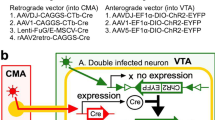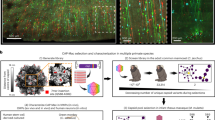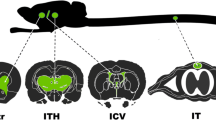Abstract
Gene transfer to central nervous system (CNS) has been approached using various vectors. Recombinant SV40-derived vectors (rSV40s) transduce human neurons and microglia effectively in vitro and in rodent brains in vivo, so we tested rSV40s gene transfer to rhesus monkey CNS in vivo, to characterize the distribution, duration and safety of such gene delivery. We used rSV40s carrying HIV-1 RevM10 with a carboxyl-terminal AU1 epitope tag as a marker, and others with the antioxidant enzymes, Cu/Zn superoxide dismutase and glutathione peroxidase. Vectors were injected stereotaxically into the caudate nucleus. Transgene expression was studied at 1 and 6 months by immunostaining serial brain sections. After intraparenchymal administration, numerous transgene-expressing cells were seen, with a longitudinal extent of 20 mm. In neurons and, more rarely, microglial cells, transgene expression remained strong throughout the 6-month study period. Astrocytes and oligodendroglia were not transduced. No evidence of inflammation or tissue damage was observed. SV40-derived vectors may thus be useful for long-term gene expression in the monkey brain and, potentially, in the human brain.
This is a preview of subscription content, access via your institution
Access options
Subscribe to this journal
Receive 12 print issues and online access
$259.00 per year
only $21.58 per issue
Buy this article
- Purchase on Springer Link
- Instant access to full article PDF
Prices may be subject to local taxes which are calculated during checkout







Similar content being viewed by others
References
Akli S, Caillaud C, Vigne E, Stratford-Perricaudet LD, Poenaru L, Perricaudet M et al. Transfer of a foreign gene into the brain using adenovirus vectors. Nat Genet 1993; 3: 224–228.
Betz AL, Shakui P, Davidson BL . Gene transfer to rodent brain with recombinant adenoviral vectors: effects of infusion parameters, infectious titer, and virus concentration on transduction volume. Exp Neurol 1998; 150: 136–142.
Naldini L, Blomer U, Gage FH, Trono D, Verma IM . Efficient transfer, integration, and sustained long-term expression of the transgene in adult rat brains injected with a lentiviral vector. Proc Natl Acad Sci USA 1996; 93: 11382–11388.
Naldini L, Blomer U, Gallay P, Ory D, Mulligan R, Gage FH et al. In vivo gene delivery and stable transduction of nondividing cells by a lentiviral vector. Science 1996; 272: 263–267.
Wu P, Phillips MI, Bui J, Terwilliger EF . Adeno-associated virus vector-mediated transgene integration into neurons and other nondividing cell targets. J Virol 1998; 72: 5919–5926.
McCown TJ, Xiao X, Li J, Breese GR, Samulski RJ . Differential and persistent expression patterns of CNS gene transfer by an adeno-associated virus (AAV) vector. Brain Res 1996; 713: 99–107.
Mandel RJ, Rendahl KG, Spratt SK, Snyder RO, Cohen LK, Leff SE . Characterization of intrastriatal recombinant adeno-associated virus-mediated gene transfer of human tyrosine hydroxylase and human GTP-cyclohydrolase I in a rat model of Parkinson's disease. J Neurosci 1998; 18: 4271–4284.
Kordower JH, Emborg ME, Bloch J, Ma SY, Chu Y, Leventhal L et al. Neurodegeneration prevented by lentiviral vector delivery of GDNF in primate models of Parkinson's disease. Science 2000; 290: 767–773.
Bosch A, Perret E, Desmaris N, Trono D, Heard JM . Reversal of pathology in the entire brain of mucopolysaccharidosis type VII mice after lentivirus-mediated gene transfer. Hum Gene Ther 2000; 11: 1139–1150.
Daly TM, Vogler C, Levy B, Haskins ME, Sands MS . Neonatal gene transfer leads to widespread correction of pathology in a murine model of lysosomal storage disease. Proc Natl Acad Sci USA 1999; 96: 2296–2300.
Skorupa AF, Fisher KJ, Wilson JM, Parente MK, Wolfe JH . Sustained production of beta-glucuronidase from localized sites after AAV vector gene transfer results in widespread distribution of enzyme and reversal of lysosomal storage lesions in a large volume of brain in mucopolysaccharidosis VII mice. Exp Neurol 1999; 160: 17–27.
Latchman DS, Coffin RS . Viral vectors for gene therapy in Parkinson's disease. Rev Neurosci 2001; 12: 69–78.
Taylor RM, Wolfe JH . Decreased lysosomal storage in the adult MPS VII mouse brain in the vicinity of grafts of retroviral vector-corrected fibroblasts secreting high levels of beta-glucuronidase. Nat Med 1997; 3: 771–774.
Watson DJ, Kobinger GP, Passini MA, Wilson JM, Wolfe JH . Targeted transduction patterns in the mouse brain by lentivirus vectors pseudotyped with VSV, Ebola, Mokola, LCMV, or MuLV envelope proteins. Mol Ther 2002; 5: 528–537.
Strayer DS . SV40 as an effective gene transfer vector in vivo. J Biol Chem 1996; 271: 24741–24746.
Strayer DS, Kondo R, Milano J, Duan LX . Use of SV40-based vectors to transduce foreign genes to normal human peripheral blood mononuclear cells. Gene Therapy 1997; 4: 219–225.
Strayer DS, Pomerantz RJ, Yu M, Rosenzweig M, Bouhamdan M, Yurasov S et al. Efficient gene transfer to hematopoietic progenitor cells using SV40-derived vectors. Gene Therapy 2000; 7: 886–895.
Cordelier P, Calarota SA, Pomerantz RJ, Xiaoshan J, Strayer DS . Inhibition of HIV-1 in the central nervous system by IFN-alpha2 delivered by an SV40 vector. J Interferon Cytokine Res 2003; 23: 477–488.
Cordelier P, Van Bockstaele E, Calarota SA, Strayer DS . Inhibiting AIDS in the central nervous system: gene delivery to protect neurons from HIV. Mol Ther 2003; 7: 801–810.
Cordelier P, Strayer DS . Using gene delivery to protect HIV-susceptible CNS cells: inhibiting HIV replication in microglia. Virus Res 2006; 118: 87–97.
Louboutin JP, Reyes BAS, Agrawal L, van Bockstaele EJ, Strayer DS . Strategies for CNS-directed gene delivery: in vivo gene transfer to the brain using SV40-derived vectors. Gene Therapy 2007; 14: 939–949.
Agrawal L, Louboutin JP, Reyes BAS, van Bockstaele EJ, Strayer DS . Antioxidant enzyme gene delivery to protect from HIV-1 gp120-induced neuronal apoptosis. Gene Therapy 2006; 13: 1645–1656.
Agrawal L, Louboutin JP, Strayer DS . Preventing HIV-1 Tat-induced neuronal apoptosis using antioxidant enzymes: mechanistic and therapeutic implications. Virology 2007; 363: 462–472.
Louboutin JP, Agrawal L, Reyes BAS, van Bockstaele EJ, Strayer DS . Protecting neurons from HIV-1 gp120-induced oxidant stress using both localized intracerebral and generalized intraventricular administration of antioxidant enzymes delivered by SV40-derived vectors. Gene Therapy 2007; 14: 1650–1661.
Louboutin JP, Agrawal L, Reyes BAS, van Bockstaele EJ, Strayer DS . HIV-1 gp120 neurotoxicity proximally and at a distance from the point of exposure: protection by rSV40 delivery of antioxidant enzyme. Neurobiol Dis 2009; 34: 462–476.
Yang Y, Haecker SE, Su Q, Wilson JM . Immunology of gene therapy with adenoviral vectors in mouse skeletal muscle. Hum Mol Genet 1996; 5: 1703–1712.
Cao H, Koeler DR, Hu J . Adenoviral vectors for gene replacement therapy. Viral Immunol 2004; 17: 327–333.
Davidson BL, Doran SE, Shewach DS, Latta JM, Hatman JW, Roessler BJ . Expression of Escherichia coli beta-galactosidase and rat HPRT in the CNS of Macaca mulatta following adenoviral mediated gene transfer. Exp Neurol 1994; 125: 258–267.
Bohn MC, Choi-Lundberg DL, Davidson BL, Leranth C, Zozlowski DA, Smith JC et al. Adenovirus-mediated gene expression in the nonhuman primate brain. Hum Gene Ther 1999; 10: 1175–1184.
Lawrence MS, Foellmer HG, Elsworth JD, Kim JH, Leranth C, Zozlowski DA et al. Inflammatory responses and their impact on beta-galactosidase transgene expression following adenovirus vector delivery to the primate caudate nucleus. Gene Therapy 1999; 6: 1368–1379.
Kaplitt MG, Leone P, Samulski RJ, Xiao X, Pfaff DW, O’Malley KL et al. Long-term gene expression and phenotypic correction using adeno-associated virus vectors in the mammalian brain. Nat Genet 1994; 8: 148–154.
Daadi MM, Pivirotto P, Bringas J, Cunningham J, Forsayeth J, Eberling J et al. Distribution of AAV2-hAADC-transduced cells after 3 years in Parkinsonian monkeys. NeuroReport 2006; 17: 201–204.
Kordower JH, Herzog CD, Biplob D, Bakay RAE, Stansell J, Gasmi M et al. Delivery of neurturin by AAV2 (CERE-120)-mediated gene transfer provides structural and functional neuroprotection and neurorestoration in MPTP-treated monkeys. Ann Neurol 2006; 60: 706–715.
Herzog CD, Dass B, Gasmi M, Bakay R, Stansell JE, Tuszynski M et al. Transgene expression, bioactivity, and safety of CERE-120 (AAV2-neurturin) following delivery to the monkey striatum. Mol Ther 2008; 16: 1737–1744.
Herzog CD, Brown L, Gammon D, Kruegel B, Lin R, Wilson A et al. Expression, bioactivity, and safety 1 year after adeno-associated viral vector type-2 mediated delivery of neurturin to the monkey nigrostriatal system support CERE-120 for Parkinson's disease. Neurosurgery 2009; 64: 602–613.
Hadaczek P, Kohutnicka M, Krauze MT, Bringas J, Pivirotto P, Cunningham J et al. Convection-enhanced delivery of adeno-associated virus type 2 (AAV2) into the striatum and transport of AAV2 within monkey brain. Hum Gene Ther 2006; 17: 291–302.
Johnston LC, Eberling J, Pivirotto P, Hadaczek P, Federoff HJ, Forsayeth J et al. Clinically relevant effects of convection-enhanced delivery of AAV2-GDNF on the dopaminergic nigrostriatal pathway in aged rhesus monkeys. Hum Gene Ther 2009; 20: 497–510.
Cunningham J, Pivirotto P, Bringas J, Suzuki B, Vijay S, Sanftner L et al. Biodistribution of adeno-associated virus type-2 in nonhuman primates after convection-enhanced delivery to brain. Mol Ther 2008; 16: 1267–1275.
Davidson BL, Stein CS, Heth JA, Martins I, Kotin RM, Derksen TA et al. Recombinant adeno-associated virus type 2, 4, and 5 vectors: transduction of variant cell types and regions in the mammalian central nervous system. Proc Natl Acad Sci USA 2000; 97: 3428–3432.
Burger C, Gorbatyuk OS, Velardo MJ, Peden CS, Williams P, Zolotukhin S et al. Recombinant AAV viral vectors pesudotyped with viral capsids from serotypes 1, 2, and 5 display differential efficiency and cell tropism after delivery to different regions of the central nervous system. Mol Ther 2004; 10: 302–317.
Dodiya HB, Bjorklund T, Stamsell J, Mandel RJ, Kirik D, Kordower J . Differential transduction following basal ganglia administration of distinct pseudotyped AAV capsid serotypes in nonhuman primates. Mol Ther 2010; 18: 579–587.
Kordower JH, Bloch J, Ma SY, Chu Y, Palfi S, Roitberg BZ et al. Lentiviral gene transfer to the nonhuman primate brain. Exp Neurol 1999; 160: 1–16.
Kato S, Inoue K-I, Kobayashi K, Yasoshima Y, Miyachi S, Inoue S et al. Efficient gene transfer via retrograde transport in rodent and primate brains using a human immunodeficiency virus type 1-based vector pseudotyped with rabies virus glycoprotein. Hum Mol Ther 2007; 18: 1141–1151.
Palfi S, Leeventhal L, Chu Y, Ma SY, Emborg M, Bakay R et al. Lentivirally delivered glial cell line-derived neurotrophic factor increases the number of striatal dopaminergic neurons in primate models of nigrostriatal degeneration. J Neurosci 2002; 22: 4942–4954.
Wolfe D, Niranjan A, Trichel A, Wiley C, Ozuer A, Kanal E et al. Safety and biodistribution studies of an HSV multigene vector following intracranial delivery to non-human primates. Gene Therapy 2004; 11: 1675–1684.
Strayer DS . Gene therapy using SV40-derived vectors: what does the future hold? J Cell Physiol 1999; 181: 375–384.
Duan YY, Wu J, Zhu JL, Liu SL, Ozaki I, Strayer DS et al. Gene therapy for human alpha1-antitrypsin deficiency in an animal model using SV40-derived vectors. Gastroenterology 2004; 127: 1222–1232.
Strayer DS, Milano J . SV40 mediates stable gene transfer in vivo. Gene Therapy 1996; 3: 581–587.
McKee HJ, Strayer DS . Immune responses against SIV envelope glycoprotein, using recombinant SV40 as a vaccine delivery vector. Vaccine 2002; 20: 3613–3625.
Louboutin JP, Chekmasova AA, Marusich E, Chowdury JR, Strayer DS . Efficient CNS gene delivery by intravenous injection. Nat Methods 2010; 7: 905–907.
Strayer DS, Lamothe M, Wei D, Milano J, Kondo R . Generation of recombinant SV40 vectors for gene transfer. SV40 protocols. In: Raptis L (ed.). Methods in Molecular Biology, vol. 16. Humana Press: Totowa, NJ, 2001, pp 103–117.
Sauter BV, Parashar B, Chowdhury NR, Kadakol A, Ilan Y, Singh H et al. A replication-deficient rSV40 mediates liver-directed gene transfer and a long-term amelioration of jaundice in gunn rats. Gastroenterology 2000; 119: 1348–1357.
Rouger K, Louboutin JP, Villanova M, Cherel Y, Fardeau M . X-linked vacuolated myopathy : TNF-alpha and IFN-gamma expression in muscle fibers with MHC class I on sarcolemma. Am J Pathol 2001; 158: 355–359.
Bigini P, Gardoni F, Barbera S, Cagnotto A, Fumagalli E, Longhi A et al. Expression of AMPA and NMDA receptor subunits in the cervical spinal cord of wobbler mice. BMC Neurosci 2006; 7: 71.
Morinville A, Cahill CM, Aibak H, Rymar VV, Pradhan A, Hoffert C et al. Morphine-induced changes in delta opioid receptor trafficking are linked to somatosensory processing in the rat spinal cord. J Neurosci 2004; 24: 5549–5559.
Nikonov AA, Finger TE, Caprio J . Beyond the olfactory bulb: an odotopic map in the forebrain. Proc Natl Acad Sci USA 2005; 102: 18688–18693.
Louboutin JP, Liu B, Reyes BAS, Van Bockstaele EJ, Strayer DS . Rat bone marrow transduced in situ by rSV40 vectors differentiate into multiple central nervous cell lineages. Stem Cells 2006; 24: 2801–2809.
Acknowledgements
This work was supported by NIH Grants ROI-MH70287 and PSI-RR000164, and RR-00164 and the Louisiana Gene Therapy Research Consortium.
Author information
Authors and Affiliations
Corresponding author
Ethics declarations
Competing interests
The authors declare no conflict of interest.
Rights and permissions
About this article
Cite this article
Louboutin, JP., Marusich, E., Fisher-Perkins, J. et al. Gene transfer to the rhesus monkey brain using SV40-derived vectors is durable and safe. Gene Ther 18, 682–691 (2011). https://doi.org/10.1038/gt.2011.13
Received:
Accepted:
Published:
Issue Date:
DOI: https://doi.org/10.1038/gt.2011.13



